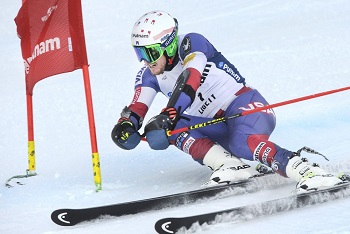
GIANT SLALOM RACING SKI DESIGN CONTROVERSY
Despite protests by many racers, the International Ski Federation (FIS) is on track to require longer, straighter giant slalom skis in World Cup and Olympic competition beginning in the 2011-12 season.
In March 2011, FIS announced that, based on a five-year study undertaken through the University of Salzburg, it had identified several areas for racing safety improvement and would require changes in course setting (to reduce racing speeds), snow conditions, and equipment design.
In regard to equipment, the FIS study measured pressure applied by experienced male racers to various GS race skis, and found that athletes applied less pressure to prototypes of longer, straighter skis than to current designs. Accordingly, FIS called for changing the minimum sidecut radius of a giant slalom ski from 27 meters to 40 meters, beginning with the 2012-13 World Cup and Europa Cup season (other FIS series will have to comply beginning with the 2013-14 season).
A storm of protest followed. Dozens of racers objected. GS World Champion Ted Ligety was the most outspoken of them. Writing in Ski Racing and on his own website, TedLigety.com, he forecast more injuries, not fewer. For one thing, Ligety argues, younger racers have spent their entire careers training on 21- and 27-meter GS skis and may not fare well reverting to a step-and-slide-to-an-edgeset method of turn initiation. The longer, straighter skis may work to the advantage of taller, stronger skiers over lighter, more agile competitors. This point also implicitly raises the issue that none of theSalzburg testers were women. In July, a letter to FIS from ski manufacturers raised technical objections, including the reality that they would need more time to design and test new skis. It was signed by executives at Amer Sports (Atomic and Salomon), Fischer, Head, Nordica, Rossignol and Stoeckli.
On August 24, 2011 FIS announced that after consultation with the Ski Racing Suppliers Association, it had revised the mandate to 35 meters for men and 30 meters for women. At the same time, maximum stand height (the distance between the ski base and boot sole) will shrink from 50mm to 45mm. The goal of the equipment changes is apparently to force a return to an earlier style of skiing, in which the turn begins with a step instead of a nearly instantaneous edge change, and the carving/accelerating portion of the turn is thus reduced.
You have to go back to the 1980s, the era of Pirmin Zurbriggen, to find race GS skis with more than a 35-meter radius. By 1990, course-setters were placing GS gates further across the fall line, and the engineers making limited-production skis for the national teams reacted by making the skis turnier – usually by reducing waist width from about 68mm to around 62mm. The 1991 K2 GS Race got into production with a 62mm waist and a sidecut radius under 32 meters, even at the 210cm length. Race-room skis from all the major factories used similar geometries, two years before Elan revolutionized the recreational sport with the SCX series of shaped skis. I have a pair of GS skis from Blizzard, circa 1991, with a 61mm waist.
In the mid-90s, with the introduction of true shaped skis, both length and sidecut radius plummeted. GS skis as short as 175cm arrived with 15-meter sidecuts.
Then FIS stepped in. For the 2003-04, minimum sidecut radius was set at 21 meters, with a 185cm minimum length for men and 180cm minimum length for women. Stand height, which affected both the leverage a skier could apply to edging and the angle at which the boot would ground on the snow, was limited to 55mm. Four years later, radius increased to 27 meters for men and 23 meters for women, stand height came down to 50mm, and the minimum waist width increased from 60mm to 65mm. The width change made a dramatic difference in the way the ski behaved on hard snow: it centralized pressure under the boot at high edging angles.
Rupert Huber, vice president for product development for Amer Sports (Atomic and Salomon), says his athletes have tested 35-meter prototypes and are satisfied they can compete successfully on them. Since 2004, Amer has been a major sponsor of the Christian Doppler Laboratory at the University of Salzburg’s Institute of Sports Science, and has used the laboratory’s findings in its own product development programs. President of Amer’s wintersports division is Dr Michael Schineis, who also serves as president of the Ski Racing Suppliers Association.
Boot and binding designer David Dodge sent FIS a letter citing previously published skiing safety research and suggesting that theSalzburgstudies were flawed. Specifically, he noted that a trained athlete will always put 100 percent effort onto a familiar piece of equipment, and be tentative on something novel – like a longer, straighter prototype. Once athletes become used to the new geometry, they will go 100 percent again. Moreover, they will angulate further to achieve today’s turning radii, leading to a rise in unstable-knee injuries.
It’s unclear why FIS singled out GS skis for attention. Over the first three years of the Salzburg study, FIS alpine racers suffered 59 severe knee injuries, defined as time loss more than four weeks. The Oslo Sports Trauma Research Centerstudied video of 20 of those injuries. Ten occurred in downhill, one in Super G, seven in GS and two in slalom. Ligety claims that over the past two seasons, only three top-30 GS stars have been hurt, and none of those crashes was caused by the skis. He also points out that both slalom specialists and downhill specialists also run GS, so that more runs happen in GS than in any other discipline. That means the frequency of injuries in GS is much lower than in downhill.
Presumably, assuming the manufacturers will allow it, FIS will eventually address the issue of binding release, or design. Then we may see some progress beyond today’s lowest-common-denominator DIN standard.
Photo: Tom Kelly/US Ski Team
